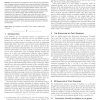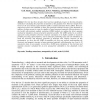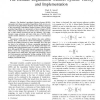102 search results - page 3 / 21 » First Steps in Synthetic Computability Theory |
PODS
2005
ACM
14 years 7 months ago
2005
ACM
Suppose we have a large table T of items i, each with a weight wi, e.g., people and their salary. In a general preprocessing step for estimating arbitrary subset sums, we assign e...
QEST
2010
IEEE
13 years 5 months ago
2010
IEEE
Traditional architecture design approaches hide hardware uncertainties from the software stack through overdesign, which is often expensive in terms of power consumption. The recen...
ECCV
2004
Springer
14 years 1 months ago
2004
Springer
—Cast shadows can be significant in many computer vision applications, such as lighting-insensitive recognition and surface reconstruction. Nevertheless, most algorithms neglect ...
CDES
2006
13 years 9 months ago
2006
: Over the last three decades there has been significant progress in the first principles methods for calculating the properties of materials at the quantum level. They have largel...
ARITH
2005
IEEE
14 years 1 months ago
2005
IEEE
— The Residue Logarithmic Number System (RLNS) represents real values as quantized logarithms which, in turn, are represented using the Residue Number System (RNS). Compared to t...



